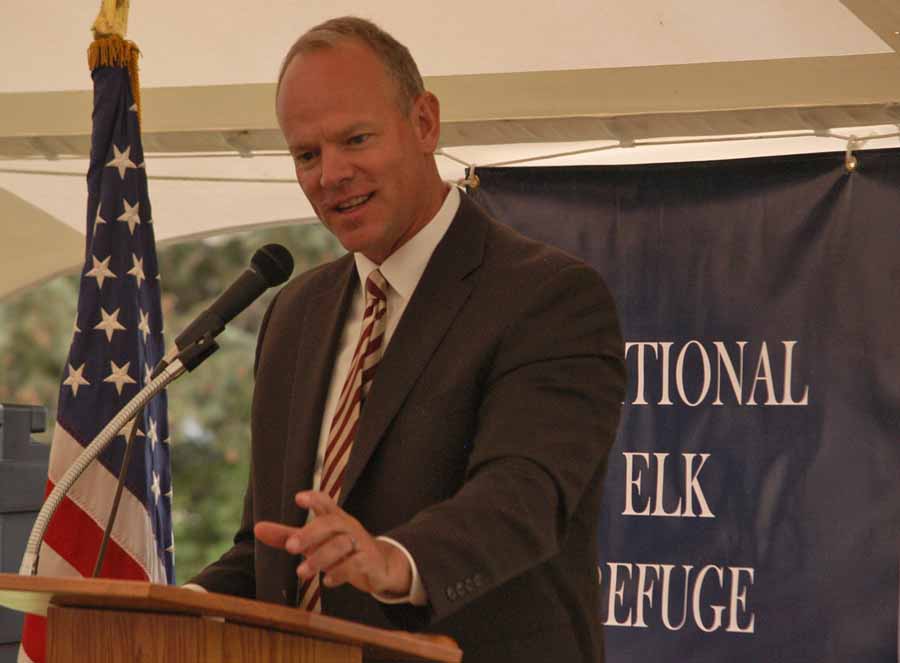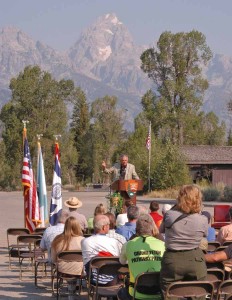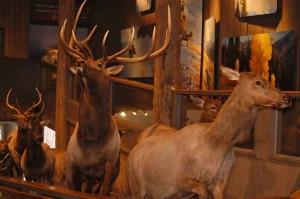
By Ruffin Prevost
JACKSON, WYO. — Two celebrations of public lands projects in Jackson Hole last week drew dignitaries from across the spectrum of state, local and federal governments, and both were praised as models of cooperative efforts that have made local landscapes more livable and sustainable.
The recent completion of the second phase of a multipurpose pathway connecting the Wyoming communities of Moose and Jackson was marked by separate events at both ends of the pathway. Also, the National Elk Refuge, spanning from the northern end of Jackson to the southern end of Grand Teton National Park, marked its centennial.
Teton County Commissioner Hank Phibbs said the pathway project “serves as an example for the rest of the country, and shows how government can function in harmony with nature.”

Phibbs was joined by Grand Teton Superintendent Mary Gibson Scott, Jackson Mayor Mark Barron and others Friday at an event at park headquarters in Moose marking completion of the pathway segment. A separate event on Saturday held in Jackson at the south end of the pathway segment was sponsored by Friends of Pathways, a local group that has helped build more than 50 miles of pathways around the area.
“This is a model for America,” Transportation Secretary Ray LaHood said of the pathway at Friday’s event.
Federal transportation funds helped build the pathway, and it was selected by Interior Secretary Ken Salazar as one of two projects in Wyoming that met the goals of the America’s Great Outdoors initiative. Launched in 2010, the initiative seeks to develop a modern approach to conservation with a recreation emphasis.
LaHood brought his grandchildren on stage to begin his remarks as a way to drive home his point that projects like the pathway yield long-term benefits for generations to come.
LaHood said the pathway offered bikers, joggers and others a chance to recreate safely in “one of the most spectacular places in the world.”
Along with this grandchildren and other family members, LaHood was spending a little extra time in Grand Teton on his first trip to Wyoming. Activities included a visit to Yellowstone National Park, a trip to the National Museum of Wildlife Art and several hikes around Jackson Hole.
“The hikes are probably the most fun,” LaHood said after his remarks. “They give you a chance to get into the woods and see the beauty of the place up close.”
The beauty of the National Elk Refuge was on full display Saturday as Wyoming Gov. Matt Mead and U.S. Fish and Wildlife Director Dan Ashe were among the speakers praising 100 years of wildlife conservation.
The nearly 25,000-acre preserve was established a century ago in an attempt to preserve the dwindling numbers of a once much larger elk herd that suffered in Wyoming’s harsh winters and had trouble migrating south as the town of Jackson expanded. It is managed by the U.S. Fish and Wildlife Service.

“It is a special feeling you get that this refuge brings you,” said Mead, who grew up in the area and has “thousands of happy memories” about visiting the refuge. Some of those memories, he said, included trips as a Boy Scout to collect shed elk antlers, which are auctioned every year to benefit the Scouts and the refuge.
Mead said the refuge is a “model of conservation,” combining hunting, art, wildlife watching and other elements of the outdoors that make the region a beloved destination.
Managing the refuge remains a controversial struggle, but one that “is well worth it,” Mead said.
More than 7,500 elk gather in a typical winter on the refuge, where they are fed in close proximity, prompting concerns by many about widespread disease transmission among elk, as well as bison that share the space.
Opponents of the feeding program, including some environmental groups that have sued to stop the practice, say it keeps elk numbers artificially high, and goes against federal mandates to manage wildlife populations for optimal levels.
With mounting legal challenges and growing public concern over the refuge’s winter feeding program, officials at Saturday’s celebration said the obvious challenge going forward will be determining how to best manage the herd for the next century.
Contact Ruffin Prevost at 307-213-9818 or [email protected].

Maybe if Guv Matt got down off his Chinese made coal powered steamroller long enough , someone might be able to make the lucid case to him why we need to close most if not all the elk feedgrounds in western Wyoming…